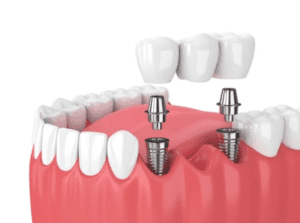Losing a tooth is much more common than people think. In fact, the American College of Prosthodontics (ACP) reports that nearly 178 million are missing at least one tooth. Whether it is due to decay or trauma, losing a tooth is nothing to be ashamed of. However, it does require immediate attention.
Your teeth work together as one unit. So, your other teeth struggle to function efficiently if one tooth is missing. Without the pressure and support of all your teeth, your teeth will shift out of place. Additionally, you are at risk of losing more teeth. Fortunately, there are many tooth replacement options available. While talking with your dentist about what is best for you, consider dental bridges.

What Are Dental Bridges?
Dental bridges literally “bridge” the gap in your smile. They are artificial teeth that use your natural teeth or other dental structures to hold them in place. Dental bridges can restore your smile regardless of the number of missing teeth or where.
A dental bridge requires healthy teeth or stable implants to support its structure. The “bridge” portion of the appliance is made of crowns—a false, tooth-like structure. The supporting teeth are called abutment teeth, and the false teeth are called pontics.
What Kinds of Dental Bridges?
A traditional fixed bridge makes up the most common type of dental bridge. This type of bridge is made of ceramic, porcelain fused to metal, or simply metal. An implant-supported bridge uses dental implants to hold and support the bridge in place.
If you are missing your front teeth, you may use a Maryland dental bridge. This is also called a resin-bonded bridge. Additionally, the bridge utilizes wings on either side of the pontic to support the structure. In fact, a dentist can even use a bridge if you only have one abutment tooth. A cantilever bridge will connect to one supporting tooth.
Are There Risks with Dental Bridges?
With any dental procedure, there are minor risks. However, the risks associated with dental bridges are small. Your surrounding teeth must be healthy to support dental bridges. If the abutment teeth develop tooth decay, then your bridges may fail.
A dental bridge can come loose even if the supporting teeth are healthy. If this happens, you will need to contact your dentist immediately in order to replace the appliance. Hopefully, your dentist will be able to reattach the bridge with new cement without damaging your other teeth.
If your bridge does come loose or fall out, you may chip or break some of your teeth. Unfortunately, if a bridge does become loose, you may have a difficult time properly cleaning your teeth, which puts you at risk of developing tooth decay.
Bottom Line
Dental bridges are a quick, cost-effective alternative for replacing missing teeth. With proper care, dental bridges can remain healthy in your mouth for up to 10 years. However, the lifespan of a dental bridge is 5-7 years. Ultimately, dental bridges allow you to reclaim the look and function of your natural teeth.
